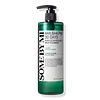What's inside
What's inside
 Key Ingredients
Key Ingredients

 Benefits
Benefits

 Concerns
Concerns

 Ingredients Side-by-side
Ingredients Side-by-side

Water
Skin ConditioningLauric Acid
CleansingGlycerin
HumectantPotassium Hydroxide
BufferingMyristic Acid
CleansingSodium Chloride
MaskingSodium C14-16 Olefin Sulfonate
CleansingLauryl Hydroxysultaine
CleansingBenzyl Glycol
SolventCoco-Betaine
CleansingSalicylic Acid
MaskingEucalyptus Globulus Leaf Oil
PerfumingButylene Glycol
HumectantEthylhexylglycerin
Skin ConditioningMelia Azadirachta Leaf Extract
Skin ConditioningDisodium EDTA
Coptis Japonica Root Extract
Skin Conditioning1,2-Hexanediol
Skin ConditioningMelia Azadirachta Flower Extract
Skin ConditioningMelaleuca Alternifolia Leaf Water
AntimicrobialEthyl Hexanediol
SolventCentella Asiatica Extract
CleansingAsiaticoside
AntioxidantMadecassic Acid
Skin ConditioningGluconolactone
Skin ConditioningCitric Acid
BufferingAsiatic Acid
Skin ConditioningMandelic Acid
AntimicrobialMadecassoside
AntioxidantArtemisia Vulgaris Extract
Skin ConditioningWater, Lauric Acid, Glycerin, Potassium Hydroxide, Myristic Acid, Sodium Chloride, Sodium C14-16 Olefin Sulfonate, Lauryl Hydroxysultaine, Benzyl Glycol, Coco-Betaine, Salicylic Acid, Eucalyptus Globulus Leaf Oil, Butylene Glycol, Ethylhexylglycerin, Melia Azadirachta Leaf Extract, Disodium EDTA, Coptis Japonica Root Extract, 1,2-Hexanediol, Melia Azadirachta Flower Extract, Melaleuca Alternifolia Leaf Water, Ethyl Hexanediol, Centella Asiatica Extract, Asiaticoside, Madecassic Acid, Gluconolactone, Citric Acid, Asiatic Acid, Mandelic Acid, Madecassoside, Artemisia Vulgaris Extract
Water
Skin ConditioningGlycolic Acid
BufferingGlycyrrhiza Glabra Root Extract
BleachingPanthenol
Skin ConditioningHyaluronic Acid
HumectantSodium Hyaluronate
HumectantSodium PCA
HumectantGlycerin
HumectantArnica Montana Flower Extract
MaskingArctium Lappa Root Extract
Skin ConditioningNasturtium Officinale Flower/Leaf Extract
AntiseborrhoeicJuniperus Communis Fruit Extract
PerfumingLavandula Angustifolia Flower Extract
CleansingAchillea Millefolium Extract
CleansingArginine
MaskingAspartic Acid
MaskingPCA
HumectantGlycine
BufferingAlanine
MaskingSerine
MaskingValine
MaskingHydrolyzed Hyaluronic Acid
HumectantSodium Hyaluronate Crosspolymer
HumectantProline
Skin ConditioningThreonine
Isoleucine
Skin ConditioningHistidine
HumectantHydrolyzed Glycosaminoglycans
HumectantBenzyl Alcohol
PerfumingSodium Lactate
BufferingPropanediol
SolventPPG-26-Buteth-26
Skin ConditioningPotassium Sorbate
PreservativeSodium Benzoate
MaskingPhenylalanine
MaskingPropylene Glycol
HumectantTetrasodium EDTA
Water, Glycolic Acid, Glycyrrhiza Glabra Root Extract, Panthenol, Hyaluronic Acid, Sodium Hyaluronate, Sodium PCA, Glycerin, Arnica Montana Flower Extract, Arctium Lappa Root Extract, Nasturtium Officinale Flower/Leaf Extract, Juniperus Communis Fruit Extract, Lavandula Angustifolia Flower Extract, Achillea Millefolium Extract, Arginine, Aspartic Acid, PCA, Glycine, Alanine, Serine, Valine, Hydrolyzed Hyaluronic Acid, Sodium Hyaluronate Crosspolymer, Proline, Threonine, Isoleucine, Histidine, Hydrolyzed Glycosaminoglycans, Benzyl Alcohol, Sodium Lactate, Propanediol, PPG-26-Buteth-26, Potassium Sorbate, Sodium Benzoate, Phenylalanine, Propylene Glycol, Tetrasodium EDTA
 Reviews
Reviews

Ingredients Explained
These ingredients are found in both products.
Ingredients higher up in an ingredient list are typically present in a larger amount.
Glycerin is already naturally found in your skin. It helps moisturize and protect your skin.
A study from 2016 found glycerin to be more effective as a humectant than AHAs and hyaluronic acid.
As a humectant, it helps the skin stay hydrated by pulling moisture to your skin. The low molecular weight of glycerin allows it to pull moisture into the deeper layers of your skin.
Hydrated skin improves your skin barrier; Your skin barrier helps protect against irritants and bacteria.
Glycerin has also been found to have antimicrobial and antiviral properties. Due to these properties, glycerin is often used in wound and burn treatments.
In cosmetics, glycerin is usually derived from plants such as soybean or palm. However, it can also be sourced from animals, such as tallow or animal fat.
This ingredient is organic, colorless, odorless, and non-toxic.
Glycerin is the name for this ingredient in American English. British English uses Glycerol/Glycerine.
Learn more about GlycerinWater. It's the most common cosmetic ingredient of all. You'll usually see it at the top of ingredient lists, meaning that it makes up the largest part of the product.
So why is it so popular? Water most often acts as a solvent - this means that it helps dissolve other ingredients into the formulation.
You'll also recognize water as that liquid we all need to stay alive. If you see this, drink a glass of water. Stay hydrated!
Learn more about Water